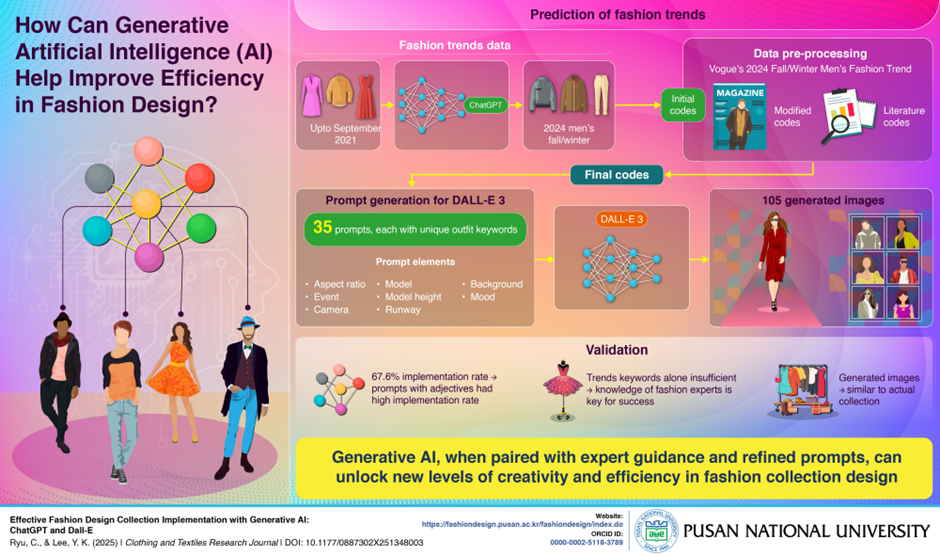
Explore How Generative AI Can Streamline Fashion Design
Generative AI models, like ChatGPT and DALL-E, may help improve fashion design efficiency and reveal emerging and current fashion trends
Generative artificial intelligence (AI) models can create entirely new text and images, offering a new avenue for efficient fashion design. Understanding how to integrate ChatGPT and AI image generators like DALL-E 3 effectively into creative fashion design is important. Recently, researchers explored the use of DALL-E 3 to visualize fashion trends according to season and generate new fashion collections. The study highlights how AI can be improved for successful fashion design implementation.

Image title: Creation of 2024 fall/winter men’s fashion collection using generative AI
Image caption: ChatGPT was effective in predicting future fashion trends using past data, while DALL-E 3 was able to incorporate these trends into generated images. However, there were also various errors, necessitating the need for expertly worded prompts from fashion designers.
Image credit: Yoon Kyung Lee from Pusan National University
License type: Original Content
Usage restrictions: Cannot be reused without permission
Generative artificial intelligence (AI) has the potential to revolutionize fashion design. By recognizing patterns in data and generating new text and images, AI models powered by deep learning algorithms can help fashion designers develop new catalogues, expanding their creativity, with added efficiency, helping to bring products to the market faster.
Large language models (LLMs) like ChatGPT and AI image generators like DALL-E have already shown promising results for many industries and have popularized the use of AI. In fashion, LLMs can help designers and even non-experts understand past styles and predict future fashion trends. These insights can then be used to generate prompts for AI image generators for producing real fashion collections. As such, it is becoming increasingly important to understand how AI can be effectively integrated into fashion.
In a recent study, Professor Yoon Kyung Lee and Master’s student Chaehi Ryu, from the Department of Clothing and Textiles at Pusan National University, South Korea, explored how generative AI can contribute to visualizing seasonal fashion trends. “To use AI effectively in fashion, we must understand the characteristics of generative AI models and make informed judgements of where they can be applied,” explains Prof. Lee. “In this study, we studied how effective prompt engineering can be used to generate realistic fashion collection images through AI.” Their study was published online in the Clothing and Textiles Research Journal on June 22, 2025.
Using ChatGPT-3.5 and ChatGPT-4, the researchers first analyzed men’s fashion trends, based on historical data up to September 2021. From this analysis, they further used ChatGPT to predict men’s fashion trends for fall/winter 2024. Design elements from these predicted trends were classified as “initial codes”. In addition, design elements from Vogue’s 2024 Fall/Winter Men’s Fashion Trend data were used as “modified codes”, and those from literature on fashion design concepts, as “codes from literature”. These elements were then analyzed and regrouped into six final codes: trends, silhouette elements, materials, key items, garment details, and embellishments.
Using these codes, they created 35 prompts for DALL-E 3, each describing a unique outfit. The prompts followed a consistent template featuring a male model walking down a runway at a 2024 Fall/Winter fashion show. The template allowed customization of different details of a real fashion collection event, including aspect ratios, events, camera angles, model appearance and height, runway design, background, and audience details, and moods. Each prompt was run three times, generating a total of 105 images.
DALL-E 3 was able to perfectly implement the prompts 67.6% of the time. Specifically, prompts with adjectives demonstrated a high implementation rate. Some images in the generated collection were very similar to the actual 2024 Fall/Winter Men’s fashion collections. However, there were errors—most images leaned toward ready-to-wear fashion, and DALL-E struggled to incorporate trend elements like gender fluidity. Trend keywords alone were insufficient to generate accurate results, indicating a need for further learning.
“Our results show that expertly worded prompts are necessary for accurate fashion design implementation of generative AI, highlighting the important role of fashion experts,” remarks Prof. Lee. “With further learning and improvements, generative AI models like DALL-E 3 will help fashion designers create entire fashion collections more efficiently, while supporting their creativity, and also help non-experts understand fashion trends.”
Overall, demonstrates that generative AI can be a powerful tool not just for professionals but also for the general public, making it easier than ever to explore, predict, and style the upcoming season’s fashion with confidence.
Reference
Title of original paper: Effective Fashion Design Collection Implementation with Generative AI: ChatGPT and Dall-E
Journal: Clothing and Textiles Research Journal
DOI: 10.1177/0887302X251348003
About the Prof. Yoon Kyung Lee
Prof. Yoon Kyung Lee is an Assistant Professor at Pusan National University, specialising in creativity and sustainability in fashion design, with a focus on AI, digital technology, and neuroscience. She holds an MSA and Ph.D. in dress aesthetics from Seoul National University, where her dissertation explored Eastern and Western philosophies through the concept of the “Hyperspace Paradigm.” A former designer in Milan, she ran her own brand, UginiO, showcasing at Seoul Fashion Week and Prêt-À-Porter Paris. She has taught at major Korean universities and was a postdoctoral and visiting scholar at the University of Minnesota with Dr. DeLong.
Lab website: https://fashiondesign.pusan.ac.kr/fashiondesign/index.do
ORCID id: 0000-0002-5118-3789
 PURCS_167_Infographics_final.jpg
(1MB)
PURCS_167_Infographics_final.jpg
(1MB)